Background:
The weather sensors are the sensing end of the weather station and collect various weather-related data. The weather station can obtain the main parameters and information of the climate, all relying on the measurement of the sensor. These seemingly small parts are the basis for the normal operation of the weather station. They are like the front soldiers and stormtroopers of climate monitoring, escorting the weather monitoring work.
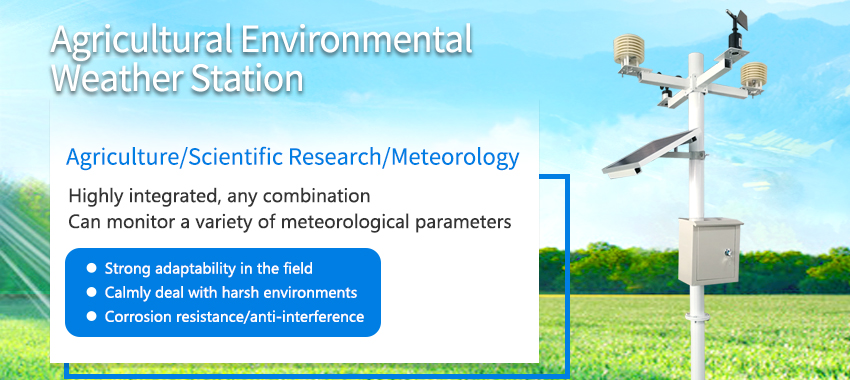
What are weather sensors?
Weather sensors are a single measurement unit that constitutes a weather station. A sensor can measure one or several meteorological elements. The combination of multiple weather sensors and a data collector and monitoring platform will become a complete weather station.
What is the need for weather sensor?
These sensors can vary between models but most measure wind speed, wind direction, temperature, relative humidity, barometric pressure, rainfall, evaporation, PAR and UV or solar radiation. Other available sensors can measure noise, negative ions, soil moisture, soil temperature, and leaf wetness.
Top 16 types of weather sensors
1. Temperature and humidity sensor
In outdoor weather monitoring, temperature and humidity sensors are one of the most basic measurement elements. The temperature and humidity measurement module itself is neither dust-proof nor water-proof, so it is usually placed in a waterproof and dust-proof solar radiation shield. It can not only protect the sensor from a harsh environment but also ensure good air permeability. The solar radiation shield has 4-20 layers to choose from. Easy to customize. This kind of meteorological temperature and humidity sensor can effectively measure the temperature and relative humidity in the atmosphere and is an outdoor temperature and humidity sensor with the highest usage rate and the best effect.
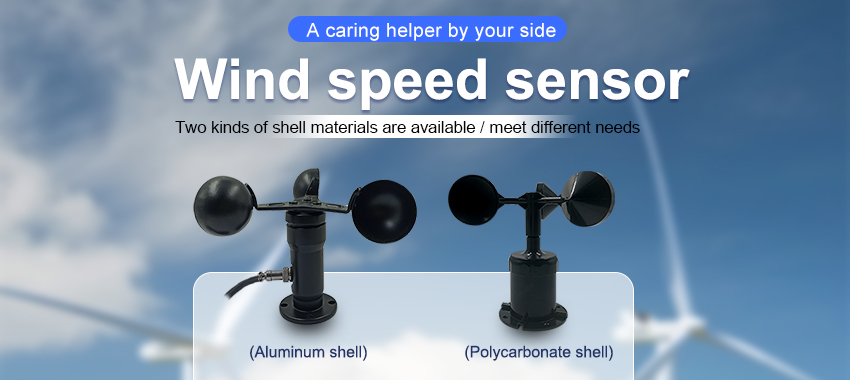
2. Wind speed sensor
The three-cup wind speed sensor is a professional meteorological instrument used to measure the wind speed near the ground. Adopting the traditional three-cup wind speed sensor structure, the wind cup is made of ABS material, which is high in strength, and at the same time cooperates with the smooth internal bearing system to start well, ensuring the accuracy of information collection. The built-in signal processing unit of the cup body can output the corresponding wind speed signal according to the user’s needs. In outdoor weather monitoring, it is usually used together with a wind direction sensor.
3. Wind direction sensor
Generally, the main body of the wind direction sensor adopts the mechanical structure of the wind vane. When the wind blows to the tail wing of the wind vane, the arrow of the wind vane will point to the direction of the wind. And pass it to the coaxial code disc, and at the same time output the physical device corresponding to the relevant value of the wind direction. The wind direction sensor can measure the near-ground wind direction in the outdoor meteorological environment. Depending on the measuring range, there are two options: eight-direction wind direction sensor and 360-degree wind direction sensor. In meteorological environment monitoring, wind speed and wind direction are the two most basic monitoring elements.
4. Rain gauge
Rainfall is a phenomenon in which water vapor in the atmosphere falls to the ground as liquid or solid water after condensation. In meteorological environment monitoring, rainfall is of great significance to meteorological research. The common meteorological rainfall monitoring equipment is a tipping bucket rain gauge. Compared with the ordinary measuring cup which is a rain gauge, the tipping bucket rain gauge has higher measurement accuracy and can directly output the value without manual reading. Generally, stainless steel rain gauges perform better in long-term outdoor monitoring.

5. Atmospheric pressure sensor
The atmospheric pressure sensor is a detection device that can feel the information of the air pressure, and can transform the detected information into an electrical signal or other required forms of information output according to a certain rule, usually composed of sensitive components and conversion components . It can be applied to air pressure and altitude measurement is a supporting product of automatic weather station.
6. Solar radiation sensor
The total solar radiation sensor is an important ground meteorological observation instrument, and it is also an indispensable equipment in the field of solar energy resource survey and photovoltaic power station operation monitoring. At present, the photoelectric total solar radiation sensor and the pyroelectric total solar radiation sensor are commonly used.
The solar radiation sensor is equipped with a specially treated transparent dust cover outside the sensing element. Its light transmittance is as high as 95%. The transparent double glass cover has good sensitivity. The surface is specially treated to prevent dust adsorption and reduce outdoor dust. Adsorption can also effectively prevent environmental factors from interfering with internal components.
7. Sunlight sensor
The sunlight sensor is a device that detects the intensity of light. The working principle is to convert the illuminance into a voltage or current value. The light sensor has a high-sensitivity photosensitive detector that can monitor artificial light and natural light and has a wide range of applications. Light sensors include a solar radiation shield type used outdoors and a wall-mounted type used indoors. In meteorological monitoring, the most commonly used solar illumination ranges are 0-10W and 0-20W.
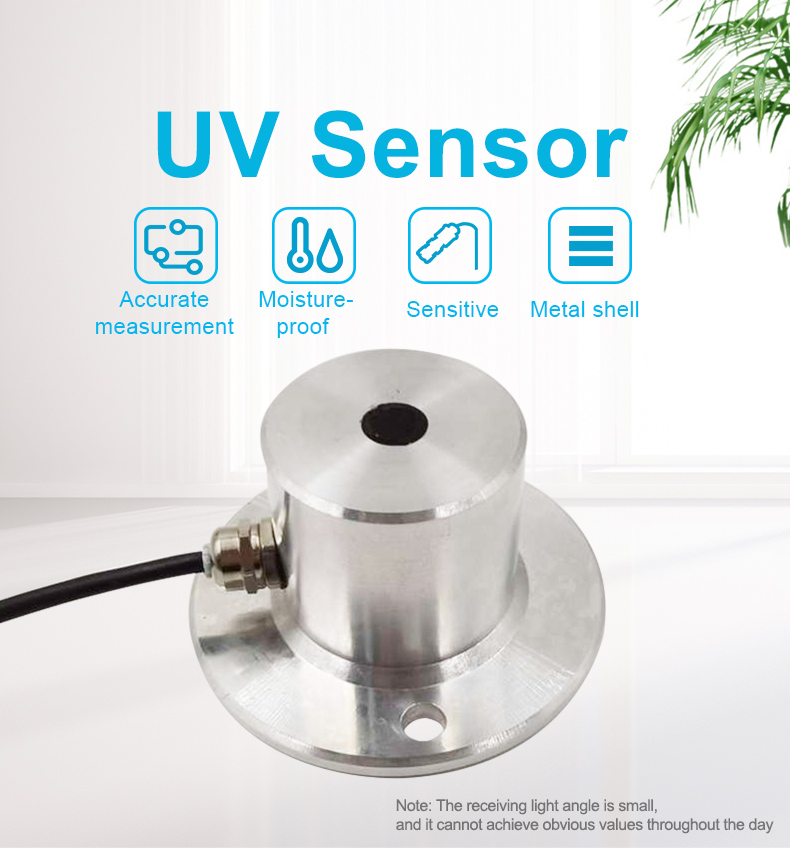
8. UV sensor
The ultraviolet sensor can use the photosensitive element to convert the ultraviolet signal into a measurable electrical signal through the photovoltaic mode and the light guide mode. When ultraviolet rays are irradiated on the ultraviolet sensor, more than 98% of the ultraviolet rays are transmitted through the see-through window made of high-quality light-transmitting materials, and irradiated on the measuring device that is sensitive to ultraviolet rays with a wavelength of 240~370nm. The imported high-precision ultraviolet sensor is internally configured. The monitoring and analysis of the U.S. are processed by a circuit with an industrial-grade microprocessor chip imported from the United States, and the ultraviolet intensity is output as an RS485 signal and displayed on the background to achieve the purpose of monitoring the ultraviolet intensity.
9. Noise sensor
The noise sensor is a high-precision sound measuring instrument that can measure the sound size and noise intensity in real time. Its monitoring range is as high as 30dB~120dB, and the measurement frequency is also relatively wide between 20~12.5KHz, which can meet various industries. The need for internal noise monitoring and measurement. In order to facilitate the installation and use in different places, the noise sensor is divided into wall-mounted and solar radiation shields. For example, the solar radiation shield noise sensor can be selected when used in outdoor weather or construction sites. Its main feature is waterproof, rain, and snow weather have no effect on it. If it is used for indoor monitoring in substations. A wall-mounted noise sensor can be selected, and the whole adopts a waterproof housing with a high degree of protection. It can be used for a long time in harsh environments such as humidity and high dust.
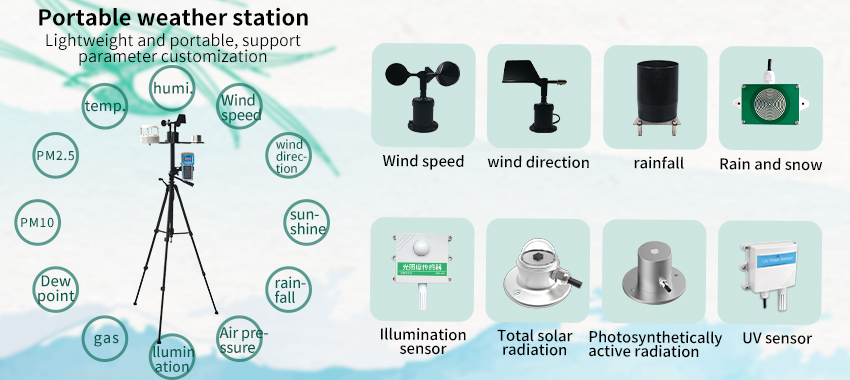
10. Rain and snow sensor
The rain and snow sensor is one of the components of the weather monitoring system. This sensor is a device specifically used to measure whether it rains or snows outdoors or in nature. Using advanced mechanical internal structure circuit module technology to develop transmitters, used to measure the presence or absence of rain and snow, and output switch signals. Optional heating function; the temperature can be controlled at about 15-20 degrees celsius. It can prevent freezing and condensation in the snow, the temperature is below 0 degrees for a long time, and the high humidity environment. And the heating temperature can be set.
11. Negative oxygen ions sensor
In the natural ecosystem, forests and wetlands are important places for generating negative oxygen ions in the air. Its concentration level is one of the indicators of urban air quality evaluation, and it is called “air vitamin”. The negative oxygen ion sensor is a special instrument for measuring gas ions in the atmosphere. It can measure the concentration of air ions, distinguish the positive and negative polarities of ions, and can distinguish the size of the measured ions according to the difference of ion mobility. Generally, a capacitive collector is used to collect the charge carried by air ions, and the current formed by these charges is measured by a micro-amperometer. The negative oxygen ion detector used in the process of weather monitoring is usually multi-functional, not only can monitor the number of negative oxygen ions, but also monitor temperature and humidity, formaldehyde, PM2.5 and TVOC and other environmental elements at the same time.
12. Evaporation sensor
Evaporation sensor is a sensor used to perceive the change of water surface evaporation, which can observe the change law of water surface evaporation in different time periods. The evaporation capacity sensor adopts the pressure measurement principle, which measures the evaporation capacity by measuring the change in the weight of the liquid in the evaporating dish, and then calculating the height of the page. This evaporation sensor can adapt to water surface evaporation measurement in various environments, and is not affected by liquid freezing. It overcomes the shortcomings of inaccurate measurement when the liquid level is measured by the ultrasonic principle, easy to damage the sensor when there is no water, and low measurement accuracy.
13. Soil moisture sensor
The soil moisture sensor is mainly used to measure soil volumetric water content, which can be used for soil moisture monitoring and agricultural irrigation and forestry protection. The soil moisture sensor consists of a stainless steel probe and a waterproof housing. It can be buried in the soil and dams for a long time to monitor the moisture content of the surface and deep soil. Used with a data collector, it can be used as a tool for fixed-point monitoring or mobile measurement of moisture. In addition, the soil moisture sensor can also integrate temperature and conductivity modules, which can simultaneously measure the three elements of soil temperature, moisture, and conductivity.
14. Soil NPK sensor
The soil NPK sensor is suitable for detecting the content of nitrogen, phosphorus, and potassium in the soil, and judging the fertility of the soil by detecting the content of nitrogen, phosphorus and potassium in the soil, thus facilitating the evaluation of the soil condition by the customer system. Its appearance is consistent with the soil moisture sensor, and it also uses a stainless-steel probe to measure changes in soil nitrogen, phosphorus, and potassium content.
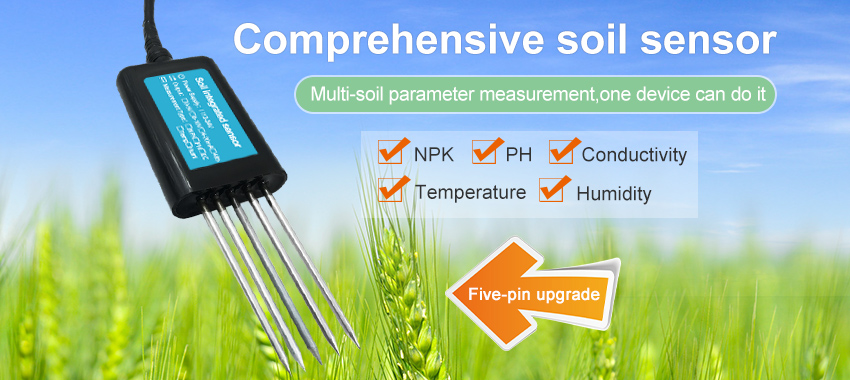
15. Soil PH sensor
The soil pH sensor is a device that measures the pH of the soil in real time. It is composed of a combination of a metal sensor and a functional value switching device. The acid-base degree of the soil has an important impact on the content of soil nutrients, ammonia, phosphorus, and potassium, and therefore has an important impact on the healthy growth of plants.
16. Leaf wetness sensor
The leaf wetness sensor can accurately measure the leaf surface humidity, and can monitor the trace moisture or ice crystal residues on the leaf surface. The shape of the sensor adopts the design of imitating the blade, which truly simulates the characteristics of the page, so it can more accurately reflect the condition of the leaf surface. It measures the amount of water or ice by imitating the change in the dielectric constant of the upper surface of the blade medium. Low power consumption, long-term uninterrupted monitoring can be carried out. It is easy to install and can be hung on the greenhouse of the greenhouse or used on the mast of the weather station.
Conclusion
All the above meteorological sensors can be connected to a weather station host. The weather station host collects and uploads the measurement data of all sensors to the cloud platform or the customer’s own platform for users to view real-time data or historical data. The above-listed are the types of weather sensors included in a complete set of weather station products. Users can choose the types of sensors they need to match freely according to their requirements. If you have any questions in the selection or application process, you can leave us a message at any time, and we will have professional technicians to answer you. You can also directly tell us what function you want to achieve, and we will provide you with a solution.JXCT Welcome to consult.